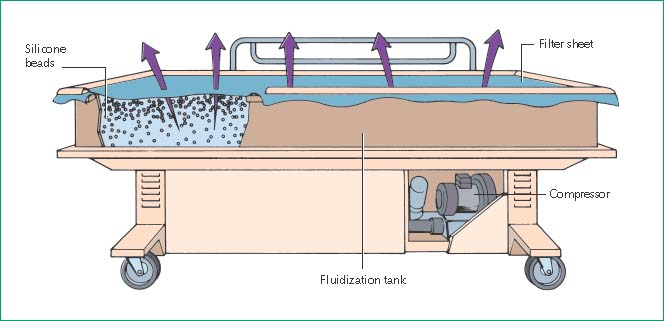Air-Fluidized Therapy Bed use
Originally designed for managing burns, the air-fluidized therapy bed is now used for patients with various debilities. By allowing harmless contact between the bed’s surface and grafted sites, the bed promotes comfort and healing.
The traditional air-fluidized therapy bed is actually a large tub that supports the patient on a thick layer of silicone-coated microspheres of lime glass. Another version combines the air-fluidized section with a low-air-loss or cushioned section. (See The air-fluidized therapy bed.) A monofilament polyester filter sheet covers the microsphere-filled tub. Warmed air, propelled by a blower beneath the bed, passes through it. The resulting fluid-like surface reduces pressure on the skin to avoid obstructing capillary blood flow, thereby helping to prevent pressure ulcers and to promote wound healing.1 The bed’s air temperature can be adjusted
to help control hypothermia and hyperthermia. The microprocessor technology also allows manipulation of various sections of the unit for optimum adjustment. Some models come with adjustable back and leg supports to promote positioning.
to help control hypothermia and hyperthermia. The microprocessor technology also allows manipulation of various sections of the unit for optimum adjustment. Some models come with adjustable back and leg supports to promote positioning.
The Air-Fluidized Therapy Bed
The air-fluidized therapy bed is a large tub filled with microspheres that are suspended by air pressure and give the patient fluidlike support. The bed provides the advantages of flotation without the disadvantages of instability, patient positioning difficulties, and immobility.
 |
The air-fluidized therapy bed may be contraindicated for a patient with an unstable spine. It may also be contraindicated for a patient who can’t mobilize and expel pulmonary secretions because the lack of back support impairs productive coughing. Operation of the air-fluidized therapy bed is complex and requires special training.
Equipment
Air-fluidized therapy bed with microspheres (about 1,650 lb [750 kg]) ▪ filter sheet ▪ flat sheet ▪ elastic cord ▪ Optional: gloves.
Preparation of Equipment
Normally, a manufacturer’s representative or a trained staff member prepares the bed for use. If you must help with the preparation, make sure the microspheres reach to within ½″ (1.3 cm) of the top of the tank. Then position the filter sheet on the bed with its printed side facing up. Match the holes in the sheet to the holes in the edge of the bed’s frame. If the bed has detachable aluminum rails, place them on the frame, with the studs in the proper holes. Depress the rails firmly, and secure them by tightening the knurled knobs to seal the filter sheet. Place a flat sheet over the filter sheet or use the specialized sheet provided by the bed company, and secure it with the elastic cord. Turn on the air current to activate the microspheres and to ensure that the bed is working properly; then turn it off.
Stay updated, free articles. Join our Telegram channel

Full access? Get Clinical Tree


